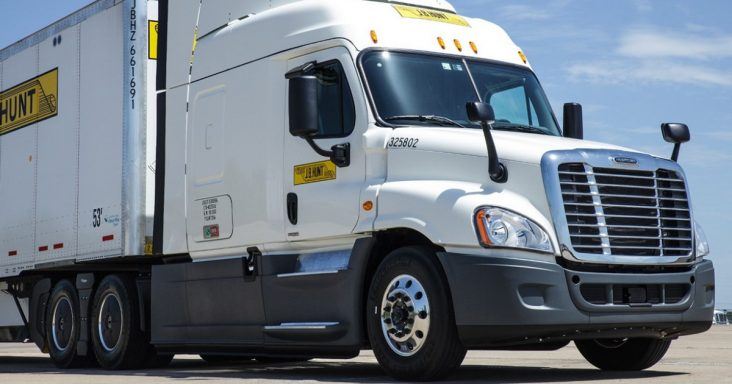Healthy economy impacts freight capacity, expectations for peak cycle growth
by October 3, 2018 7:05 pm 626 views

The transportation sector is benefiting from a healthy economy, and this has led to tight truckload and intermodal capacity and expectations for a strong peak season, analysts said. Also tightening is the driver market as the turnover rate continued to rise in the second quarter.
The turnover rate rose to its highest level since 2015, increasing to 98% in the second quarter, according to trade organization American Trucking Associations (ATA).
“So far this year, the turnover rate at large truckload fleets is up 10 percentage points,” said ATA Chief Economist Bob Costello. “The extreme tightening of the driver market — driven by solid freight demand — will continue to challenge fleets looking for qualified drivers.”
However, investors are concerned that 2018 is the peak of the cycle and have become more reluctant to put money into the majority of transportation stocks, and as a result, a team of Stephens transportation analysts believe the safest investment in the sector is in railroad stocks as their pricing power is more insulated, more potential for freight conversions from truck to rail and margin expansion opportunities. The team included analysts Brad Delco, Jack Atkins, Justin Long and associates Scott Schoenhaus, Andrew Hall and Brian Colley.
Recently, the team took field trips to several transportation companies, including Lowell-based carrier J.B. Hunt Transport Services, and met with company executives. They discussed healthy economic trends, a strong outlook for peak season, pricing momentum, the duration of the up-cycle and earnings growth drivers. The healthy economy has led rail volumes to rise 4% in the third quarter, from the same period last year, and strong retail sales have absorbed much of the earlier increase in inventory related to tariff and trade concerns.
“Combined with consumer confidence hitting all-time highs and bullish commentary from a variety of retailers, we believe the tone around the economic backdrop is positive,” according to the Stephens analysts. “Tariff/trade developments remain a longer-term macro uncertainty; however, we think the near-term impact has been fairly minimal within the transportation sector.”
Transportation companies are expecting a strong peak season, and some intermodal providers have indicated they have no more available capacity for the season. Also, carriers have experienced positive pricing, and many are seeing the best pricing in decades, the analysts said. Truckload and intermodal contract rates have been rising between the high single digits and low double digits. While some investors are concerned the pricing could reverse in 2019, the analysts believe carriers and shippers expect price increases again next year. How much prices will rise is uncertain, but intermodal pricing could rise more quickly than truckload pricing because of freight conversions to rail from truck and likely better service next year.
Next year could be good for J.B. Hunt, which could see the potential for growth in intermodal and dedicated margin improvements as startup costs fall. However, the carrier’s intermodal volumes, while rising, have been impacted by rail service issues. In July, load growth was near the low single digits, compared to the 8% growth in the same month in 2017, according to the analysts. The change was a result of slower trains and longer dwell times, and this has negatively impacted volumes. August volumes likely followed a similar trend.
Regarding pricing, J.B. Hunt is operating in one of the best intermodal pricing environments in recent history heading into peak season. The analysts believe that intermodal capacity is sold out through the end of the year, and the carrier should be able to benefit from re-positioning fees and better freight opportunities for customers needing capacity.
Demand for dedicated freight capacity remains strong for J.B. Hunt, and so does its backlog for new dedicated business, analysts said. Revenue and earnings from its dedicated segment should continue to increase as it adds new dedicated customers, and this growth is projected over the next several years. The analysts believe the company is trying to add three times the number of new customers this year, compared to its historical average. The focus continues to be one private fleet conversions, and J.B. Hunt has had the ability to secure out-of-bid rate increases on existing contracts, with 70% of contracts having built-in cost escalators, up from 50% last year.
In 2017, the carrier announced a $500 million investment into technology over five years, and this investment has started to pay off with improved efficiencies, including time-stamped deliveries, freight geo-tracking and isolating and reducing misuse from other carriers. This was possible as a result of the carrier installing sensors in its more than 90,000 containers and trailers. The technology was about 98% installed at the time the analysts met with company executives.
Also, as the carrier’s mobile app is updated, improvements are expected for automated detention, document uploading and in-app invoicing. The analysts believe the company is focused on wide-spread adoption of their technology platform instead of productivity improvements, as the carrier continues to make use of its customer base across its multiple business segments. The 12-month target for shares is $138, and the analysts maintain a buy rating for the stock.
Shares of J.B. Hunt (NASDAQ: JBHT) closed Wednesday (Oct. 3) at $120.65, up 28 cents. In the past 52 weeks, the stock has ranged between $131.74 and $100.25.
On Oct. 16, J.B. Hunt is expected to report third-quarter earnings will rise 52 cents to $1.43 per share, from 91 cents per share in the same period last year, according to a consensus of 22 analysts. Revenue is expected to increase 20.4% to $2.22 billion.
